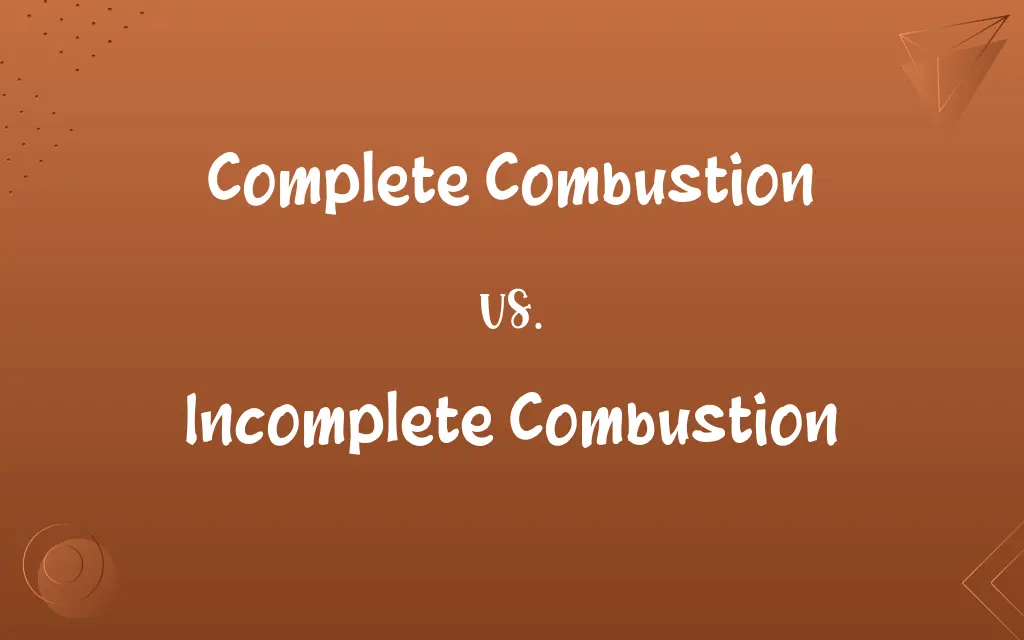Complete Combustion vs. Incomplete Combustion: Know the Difference

By Shumaila Saeed || Published on January 4, 2024
Complete combustion fully oxidizes fuel with adequate oxygen, producing carbon dioxide and water, while incomplete combustion results in carbon monoxide, soot, and less energy.

Key Differences
Complete combustion happens when a fuel burns in plenty of oxygen, producing maximum energy. It results in carbon dioxide and water as the main products. In contrast, incomplete combustion occurs with insufficient oxygen, leading to incomplete oxidation of the fuel. This process produces carbon monoxide, soot, or smoke, indicating inefficient fuel use and potential hazards.
Shumaila Saeed
Jan 04, 2024
In complete combustion, the fuel utilization is efficient, ensuring that all carbon in the fuel is converted to carbon dioxide. This type of combustion is ideal for maximizing energy output and reducing harmful emissions. Incomplete combustion, however, leads to the release of unburnt hydrocarbons and carbon monoxide, which are harmful to both health and the environment.
Shumaila Saeed
Jan 04, 2024
Complete combustion typically requires a well-designed fuel system that ensures adequate oxygen supply. This process is characterized by a blue flame in gas burners, symbolizing optimal burning. Incomplete combustion, on the other hand, often exhibits a yellow or orange flame, indicating the presence of soot and other particulates resulting from insufficient oxygen.
Shumaila Saeed
Jan 04, 2024
In terms of heat generation, complete combustion is more effective, as it converts more fuel into usable heat. It is preferred in industrial and domestic heating systems for its efficiency and lower emission rates. Incomplete combustion, though less efficient, can occur in everyday scenarios like poorly adjusted stoves or engines, leading to higher emissions and potential health risks.
Shumaila Saeed
Jan 04, 2024
Complete combustion, being more environmentally friendly, is favored in green technology and sustainable practices. Incomplete combustion not only wastes fuel but also contributes to air pollution and health issues, making it undesirable in both residential and industrial settings.
Shumaila Saeed
Jan 04, 2024
ADVERTISEMENT
Comparison Chart
Flame Color
Blue flame indicating complete burn
Yellow/orange flame, indicating soot
Shumaila Saeed
Jan 04, 2024
Main Products
Produces carbon dioxide and water
Produces carbon monoxide, soot, and smoke
Shumaila Saeed
Jan 04, 2024
Energy Efficiency
More efficient, maximizing energy output
Less efficient, losing energy as unburnt fuel
Shumaila Saeed
Jan 04, 2024
Environmental Impact
Lower emissions, more eco-friendly
Higher emissions, contributes to pollution
Shumaila Saeed
Jan 04, 2024
ADVERTISEMENT
Complete Combustion and Incomplete Combustion Definitions
Complete Combustion
Complete combustion results in maximum energy release and minimal pollutants.
A well-maintained car engine achieves complete combustion, optimizing fuel usage and reducing exhaust emissions.
Shumaila Saeed
Dec 19, 2023
Incomplete Combustion
Incomplete combustion is less efficient, wasting fuel and energy.
A malfunctioning furnace may result in incomplete combustion, reducing heating efficiency and increasing fuel costs.
Shumaila Saeed
Dec 19, 2023
Complete Combustion
It involves converting all carbon in the fuel to carbon dioxide.
Industrial boilers designed for complete combustion efficiently convert fuel into heat with minimal waste.
Shumaila Saeed
Dec 19, 2023
Incomplete Combustion
Incomplete combustion occurs when fuel burns in insufficient oxygen.
A poorly ventilated fireplace often leads to incomplete combustion, producing smoke and carbon monoxide.
Shumaila Saeed
Dec 19, 2023
Complete Combustion
Complete combustion is characterized by a blue flame and complete fuel utilization.
The blue flame in a gas stove indicates complete combustion, ensuring efficient cooking.
Shumaila Saeed
Dec 19, 2023
ADVERTISEMENT
Incomplete Combustion
It leads to the formation of carbon monoxide and particulate matter.
In an old car, incomplete combustion can cause the exhaust to emit black smoke, a sign of unburnt fuel.
Shumaila Saeed
Dec 19, 2023
Complete Combustion
It is essential for reducing environmental impact in fuel burning.
Modern heating systems focus on complete combustion to minimize carbon footprint.
Shumaila Saeed
Dec 19, 2023
Incomplete Combustion
It is marked by a yellow or orange flame and the presence of soot.
A candle burning with a flickering yellow flame is an example of incomplete combustion.
Shumaila Saeed
Dec 19, 2023
Complete Combustion
Complete combustion is the full oxidation of fuel with ample oxygen.
In a gas furnace, complete combustion ensures efficient heating with minimal emissions.
Shumaila Saeed
Dec 19, 2023
Incomplete Combustion
Incomplete combustion poses environmental and health risks.
Industrial processes with incomplete combustion contribute significantly to air pollution.
Shumaila Saeed
Dec 19, 2023
Repeatedly Asked Queries
What are the signs of incomplete combustion?
Signs include a yellow/orange flame, presence of soot, and the emission of carbon monoxide.
Shumaila Saeed
Jan 04, 2024
What color flame indicates complete combustion in gas burners?
A blue flame indicates complete combustion.
Shumaila Saeed
Jan 04, 2024
Is complete combustion environmentally friendly?
Yes, it produces fewer pollutants and is more eco-friendly.
Shumaila Saeed
Jan 04, 2024
Can incomplete combustion cause health issues?
Yes, due to the release of carbon monoxide and particulate matter.
Shumaila Saeed
Jan 04, 2024
Why does incomplete combustion produce soot?
Due to incomplete oxidation of the carbon in the fuel.
Shumaila Saeed
Jan 04, 2024
What is complete combustion?
Complete combustion fully oxidizes fuel in excess oxygen, producing carbon dioxide and water.
Shumaila Saeed
Jan 04, 2024
Does incomplete combustion affect fuel economy?
Yes, it leads to inefficient fuel use and higher costs.
Shumaila Saeed
Jan 04, 2024
Can incomplete combustion be dangerous?
Yes, it produces carbon monoxide, a harmful and potentially lethal gas.
Shumaila Saeed
Jan 04, 2024
How can one ensure complete combustion in a furnace?
Regular maintenance and ensuring adequate oxygen supply ensure complete combustion.
Shumaila Saeed
Jan 04, 2024
Why is complete combustion preferred in industrial settings?
It's more efficient, maximizes energy output, and reduces emissions.
Shumaila Saeed
Jan 04, 2024
What happens to the carbon in fuel during complete combustion?
It is fully oxidized to carbon dioxide.
Shumaila Saeed
Jan 04, 2024
What role does oxygen play in complete combustion?
Oxygen is necessary to fully oxidize the fuel.
Shumaila Saeed
Jan 04, 2024
What steps can be taken to reduce incomplete combustion in industries?
Implementing efficient fuel-burning technologies and regular equipment maintenance.
Shumaila Saeed
Jan 04, 2024
What are common causes of incomplete combustion in household appliances?
Poor ventilation and improperly adjusted burners can cause incomplete combustion.
Shumaila Saeed
Jan 04, 2024
What are the main products of complete combustion?
Carbon dioxide and water.
Shumaila Saeed
Jan 04, 2024
Is it possible to achieve complete combustion in a car engine?
Yes, with proper maintenance and efficient design.
Shumaila Saeed
Jan 04, 2024
Can incomplete combustion occur in natural gas appliances?
Yes, if the appliance is poorly adjusted or lacks proper ventilation.
Shumaila Saeed
Jan 04, 2024
How does incomplete combustion contribute to air pollution?
It releases unburnt hydrocarbons and carbon monoxide into the air.
Shumaila Saeed
Jan 04, 2024
How can one detect carbon monoxide from incomplete combustion?
Through carbon monoxide detectors installed in homes and buildings.
Shumaila Saeed
Jan 04, 2024
What are the economic impacts of incomplete combustion?
Increased fuel costs and potential damage to appliances.
Shumaila Saeed
Jan 04, 2024
Share this page
Link for your blog / website
HTML
Link to share via messenger
About Author
Written by
Shumaila SaeedShumaila Saeed, an expert content creator with 6 years of experience, specializes in distilling complex topics into easily digestible comparisons, shining a light on the nuances that both inform and educate readers with clarity and accuracy.









































































